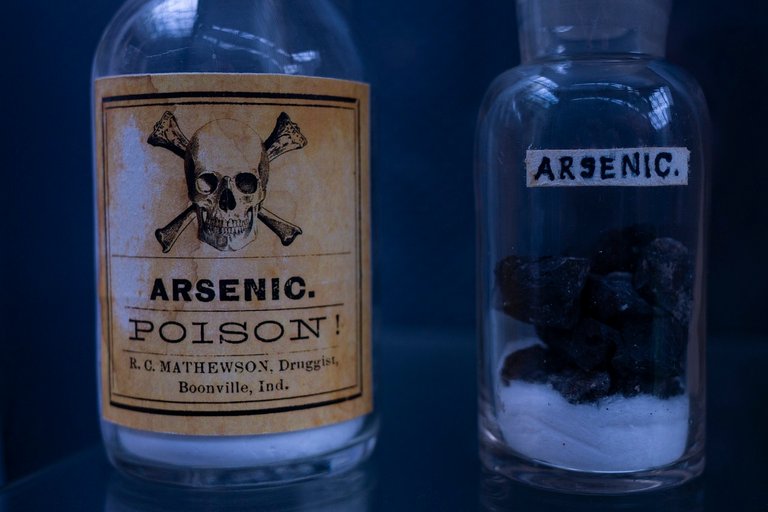Inorganic Metallic Poisoning - Arsenic and Copper Poisoning
I discussed Inorganic Metallic Poisoning in my previous post starting with Lead Poisoning, and I will be continuing on Inorganic Metallic Poisoning in this post. To Begin, I will discuss Arsenic Poisoning, then we will talk about copper poisoning.
Arsenic is a gray substance that is insoluble in water and in its gray form, it is not poisonous but it becomes a poison when converted into Arsenic Trioxide (AS2O3) which is the whitish form. When arsenic combines with the sulfhydryl groups of enzymes involved in the metabolism of cells thereby inhibiting cellular metabolism and depressing the nervous system. It is also an irritant poison when it has local contact. Arsenic can be in different forms such as the oxides of arsenic, sulfide of arsenic, and Copper form of arsenic. The Oxide form of arsenic which is Arsenic Trioxide (AS2O3) exists in the opaque brittle mass-like form and the white crystalline powdered form. The sulfur arsenic exists in two forms which are a yellow color orpiment, and a red realgar. Other types of arsenate are lead arsenate, potassium arsenate, and sodium arsenate.
Arsenic poisoning can be acute or chronic. Acute arsenic poisons have symptoms that vary depending on the onset of symptoms. These symptoms can be divided into acute, subacute, and narcotic. Acute arsenic poisoning is predominant in the gastrointestinal tract and occurs between 15 to 30 minutes after ingestion, and death can occur in 1 to 2 days. The poisoned person can start to vomit stomach content, after which they start to vomit bile, the patient experiences burning pain, and the vomiting can be continuous where the person starts to vomit mucus and blood. Poisoned patients will have diarrhea which is accompanied by tenesmus, blood, and fragments of the poison. Patients will experience increased dehydration and when the patient drinks water, the vomiting is continuous. Patients with acute poisoning can experience dilated pupils, pale-looking, have sunken eyes, and patients can collapse. Subacute poisoning is a phase after the acute attack. A patient gets to this phase if they overcome the acute attack. With subacute poisoning, death can occur between 7 to 10 days. The degree of symptoms is less severe, with an increased duration period. Patients can die of cardiac failure in this phase of acute arsenic poisoning. The last phase of Acute poisoning is Narcortic arsenic poisoning, which occurs as a result of the ingestion of a a large dose of Arsenic that leads to vascular collapse, and spasm even before irritation begins. With narcotic arsenic poisoning, death can occur between 2 to 3 hours. The lethal dose of arsenic in the acute type of poisoning is between 120 to 200 milligrams in adults. Treatment will be stomach wash, which can be done with warm water or milk, Patients should not be given alkalis as it increases the solubility of the poisoning leading to death. Ferric oxide should be given as an antidote to the poisoned patient. Ferric oxide converts the arsenic to ferric arsenate which is a harmless form of arsenate. Also as an antidote, charcoal can be given to the patient. Postmortem findings of arsenic poisoning will be dehydration, sunken eyes, and jaundiced skin due to liver failure, remains will last longer at rigor motifs as a result of the poisoning. Inside the body, in the stomach patches, blood will be seen in it, and there will be hemorrhages in the lungs, trachea, and larynx.

https://www.amgrow.com.au
Chronic arsenic poisoning can occur as after effect of acute arsenic poisoning, it can also be a result of continuous ingestion of small doses over time, and from contaminated water and food. This poisoning can show symptoms that span through nutritional or GIT disturbances, Catarrhal changes, Skin rash, and nervous disturbances. Patients will experience nausea, vomiting, diarrhea, common cold, conjunctivitis, Bronchial catarrh, and skin rashes that can be raindrop pigmentation. Treatment includes disconnection from the exposure, vitamin B Complex, and IV thiosulphate, the patient is treated symptomatically, and the treatment can last up to one year. The decomposition of the body is retarded in postmortem findings.
Copper poisoning is another Inorganic Metallic Poisoning. When I say copper, I do not mean the metallic solid ones you use in electricity, that aren't poisonous. The salt copper which includes copper sulfate, copper subacetate, copper arsenide, and Copper Acetoarsenite is poisonous. The sulfate has a blue crystal shape, the subacetate is a bluish-green mass of powder, and Copper Acetoarsenite presents as an emerald-green crystalline. Copper poisoning inhibits enzymes and the signs and symptoms (acute poisoning) are exhibited in 15 minutes, affecting the liver, the kidneys, the Gastrointestinal tract, the central nervous system, the circulatory system, and the respiratory muscles. It causes vomiting (blue and green color) which can be proven by the addition of ammonium hydroxide bringing out blue color, patients will have jaundice, excessive urea in blood, convulsion, decreased urine, headache, coma, respiratory difficulty, and muscle spasm. 30gm of CuSO4 and subacetate is fatal within 12 to 24 hours. Treatment of acute poisoning is using potassium ferrocyanide to wash the stomach, use of demulcent, and administering Penicillamine BAL and EDTA as antidotes. Chronic copper poisoning shows similar symptoms that lead poisoning, symptoms of Wilson's disease.
https://pmj.bmj.com/content/79/933/391
https://www.ncbi.nlm.nih.gov/books/NBK541125/
https://www.mountsinai.org/health-library/poison/copper-poisoning
https://www.ncbi.nlm.nih.gov/books/NBK557456/


These chemicals are poisonous and kills very fast. Just hope they are not kept close to non professionals. Thank you for the lecture
That's the thing, once the chemicals are handled by professionals then it's a good thing.
Thanks for your contribution to the STEMsocial community. Feel free to join us on discord to get to know the rest of us!
Please consider delegating to the @stemsocial account (85% of the curation rewards are returned).
Thanks for including @stemsocial as a beneficiary, which gives you stronger support.